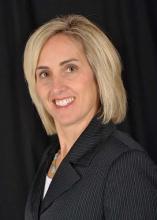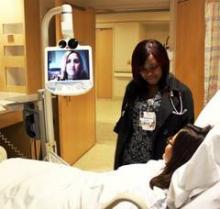Dana P. Giarrizzi: Telemedicine is a new frontier for the hospitalist
National Medical Director for Telehospitalist Services, Eagle Hospital Physicians
Developed the Eagle telehospitalist program
National speaker on telemedicine
Trend to watch: "Beaming in" on inpatients nationwide
Dr. Dana Giarrizzi usually creates a bit of a stir when she first enters a patient’s room. That’s because the patient is seeing her face on a computer screen mounted on a robot. Using a control station in South Carolina, Dr. Giarrizzi wheels into the room, using the mounted camera to make eye contact with the patient, and introduces herself. From that point on, she conducts a typical physical exam with the help of an on-site nurse or physician assistant and using a stethoscope attached to the robot.
Dr. Giarrizzi, who "beams in on" hospitalized patients all across the country, calls herself a telehospitalist. She began her career as a traditional internal medicine hospitalist but shifted her focus to telemedicine around 2009, when she began researching how a telehospitalist program could work at Eagle Hospital Physicians, a physician services company. Today, she is the national medical director for telehospitalist services at Eagle and oversees a group of about eight telehospitalists, with more in the pipeline. The Eagle telehospitalists mainly help small hospitals provide coverage for hard-to-fill shifts at night, but they also provide surge capacity at large urban centers, she said.
In an interview with Hospitalist News, Dr. Giarrizzi talked about the reaction she gets from patients and what is driving the growth in telemedicine in the hospital.
Question: What was it like the first time you "beamed in" on a patient remotely using the robot?
Dr. Giarrizzi: Some of the first patients I saw were just amazed. In the beginning, a lot of them kind of look at you like a deer in the headlights, even the nurses. In the first few months, I had all kinds of people in the room watching me, from the secretaries to the housekeeping staff. They were all watching what was going on. I would be seeing a patient, and all of a sudden I would see this flash. I thought, ‘It’s not raining in Kentucky.’ And I would look out the window and realize it was parents of a 19-year-old taking a picture of me admitting their daughter for an acute appendicitis.
[Check out a video of Dr. Giarrizzi at work with her robot here.]
Question: Is telemedicine growing in the hospital setting?
Dr. Giarrizzi: I think it is growing. There’s just no way around it. This isn’t the solution for health care, but it certainly is a part of it and it’s only going to grow. It already is growing in all kinds of ways. There’s telehospitalists, telepsychiatry, and teleneurology.
Question: What is driving the growth?
Dr. Giarrizzi: No. 1: There are just not enough doctors. You can close your eyes and put your finger on a map and get a job anywhere as a hospitalist. You also have small towns where no one really wants to move. And there are just so many more patients who are hitting the age where they need health care. With all of the health care changes, people who are close to retirement age are saying, "You know it’s not worth it to me, I’m just going to retire." There are just not enough of us.
Question: This is a new area. Are hospitalists trained to provide these services via telemedicine?
Dr. Giarrizzi: Of course they don’t do it in residency yet, but they don’t teach us how to bill in training either. For us at Eagle, we pick the cream of the crop. We’re not going to make a doctor who doesn’t have a personality suddenly have one on the computer. We have a couple of tools that we’ve developed to try to pick the right people. I pick the people on an individual basis, and we take them through some training that we’ve developed. The technology is part of it. Having some background in that is important, but it’s not necessary.
Question: What settings are the best fit for a telehospitalist?
Dr. Giarrizzi: In general, anyone can benefit from this technology. Once you have the equipment, you can add on other services. Let’s just say you have teleneurology capability. If the hospital chooses, they can add telepsychiatry and telehospitalists. That’s one part of it. Right now, the easiest way to think about telehospitalists is by asking, what are the hardest shifts to fill? Nights. Nights in rural areas are the hardest, especially if you’re talking about small hospitals. Some of the larger cities use telemedicine for surge capacity or to fill temporary gaps. But telemedicine really is not something that is limited. It’s so individual to the community and the hospital’s needs. It’s wide open.








